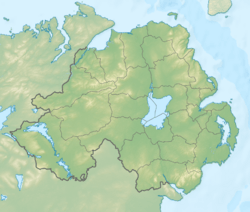Occupation of Cullaville facts for kids
Quick facts for kids Occupation of Cullaville |
|
|---|---|
| Part of the Troubles | |
 |
|
| Location | Cullaville, County Armagh, Northern Ireland |
| Coordinates | 54°03′43.20″N 6°38′38.12″W / 54.0620000°N 6.6439222°W |
| Date | 22 April 1993 17:00 (UTC) |
|
Attack type
|
Armed occupation |
| Weapons | Assault rifles, heavy machine guns, 1 sniper rifle, 1 rocket launcher |
| Perpetrator | Provisional IRA |
The occupation of Cullaville was an event that happened on 22 April 1993. About 12 armed members of the Provisional Irish Republican Army (IRA) took control of the main crossroads in the small village of Cullaville, County Armagh, Northern Ireland. They held the village for two hours. This happened even though a British Army watchtower was very close by. The IRA members left before the security forces could respond.
What Led to the Event
For many years, the British Army found it difficult to use roads in south County Armagh. This was because of the danger of hidden bombs, called culvert mines. Most military movements, like bringing supplies to bases, had to be done by helicopter.
In 1974, the IRA had briefly set up a checkpoint in Cullaville. They did this to safely remove a bomb they had planted earlier.
The British Army tried to stop illegal roadblocks. However, the IRA continued to set them up. In 1981, an ambush by the IRA led to the death of a British soldier.
In 1984, the British Army started building 12 tall watchtowers along the border with the Republic of Ireland. These towers were meant to make it harder for the IRA to move around freely. Getting materials and people to build these towers was a huge operation for the British Army.
However, the IRA studied these watchtowers carefully. They found that the towers could only see about 35% of the area, even in good weather. This meant there were many "blind spots." In 1992, 15 IRA members set up checkpoints in another village, Meigh, without any interference from British forces.
The Cullaville Action
On 22 April 1993, around 5:00 PM, 12 IRA members set up an armed checkpoint in the middle of Cullaville. They effectively took control of the village. They began stopping drivers and asking for their identification.
The IRA team had many weapons. These included AK-47 rifles, M60 machine guns, a special sniper rifle, a rocket launcher, and a DShK heavy machine gun. They used the natural dips and rises in the land to hide themselves from the British Army watchtower. This tower was only about 200 yards away. The IRA in South Armagh was known for being very good at using the landscape to their advantage.
After two hours, the IRA members left without being stopped. Some people said the watchtower might not have had anyone in it at the time. Other reports suggested the IRA wanted to trick British troops into coming to the village so they could ambush them. This time, the IRA group did not have help from the Irish side of the border.
What Happened Next
This event caused strong reactions from politicians in both London and Dublin. Seamus Mallon, a Member of Parliament for Newry and Armagh, said the incident showed that the British government's approach to Northern Ireland was wrong. He felt that focusing too much on "emergency laws" and "security" created a distance between the police and the community. This meant that important information was not being shared.
Michael Mates, a government minister for Northern Ireland, was asked why the British Army did not act. He said that the land allowed the IRA to hide from the watchtower. He also mentioned that it was possible the IRA was trying to lure troops into an ambush.
Bill Cotter, a politician in Ireland, used the incident to show that tensions were growing. He said it was clear that armed groups could take over towns whenever they wanted. He also worried about a lack of attention to national security by the government.
See also
- The Troubles in Cullaville
- South Armagh Sniper (1990-1997)
- Chronology of Provisional Irish Republican Army actions (1990-1999)


